Circle-time, or “morning meeting” is often a valued component of the school day. Educators view this as an important time to address social skill development, as well as to introduce and review academic concepts.
Typically, these groups emphasize attending, imitating, listening, and turn taking, and may require students to share materials and wait for periods of time. For many students and staff members, morning meeting is a preferred activity that allows for creativity, interaction, and fun.
For students with autism spectrum disorder (ASD), however, these language-based groups may be challenging. The challenges may arise due to difficulties some students with ASD have with distractibility, sequencing information, auditory processing, and social skill development.
Though circle-time may be difficult for students with ASD, with the appropriate modifications and additions to the activities and environment, the experience can be successful for students and staff alike. Following are a number of ideas that will help make morning meetings more meaningful to students, and will assist in increasing student success.
The layered group
Catherine Faherty of Division TEACCH® encourages staff to start with the “lowest common denominator” when planning group activities that may include students with autism (Faherty, n.d.).
The first layer of the group may include all of the students in the class and include lively activities, such as music, or concrete and clear routines, such as counting. When this “layer” is finished, students who are currently able to handle only a short group are directed to another activity. It is important that students are transitioned to another activity while they are still successful — a shorter, yet positive, group time is preferred.
The next layer of the group activity will include greater language demands, and will address more abstract concepts. Students may discuss the weather, calendar, lunch menu, or daily attendance. The second group of students would then be transitioned to alternate activities when this layer is finished (and may be monitored by a staff member who typically would be supervising students at the morning meeting).
Finally, the smallest group of students will engage in the most abstract language-focused activities, such as conversation and discussion. As students gain skills, they may begin to stay for additional layers.
The layered group concept encourages staff to plan activities that are meaningful for students at a variety of skill levels, and emphasizes that expectations around student participation at circle-time can, and should, vary.
An engineered environment
Because morning meetings may target deficit areas for students with ASD, it is important to provide additional supports to increase student success. Consider the following questions when designing the physical environment:
- Is the area free of distracting information?
- Is meaningful and salient information highlighted?
Students with ASD may find it difficult to prioritize the importance of information, and may become overwhelmed if too much information is presented at one time. Photo 1 is an example of a circle-time area that has too much information — thus making it difficult for students to find meaning in the environment, and to attend to the appropriate activity.
Photo 1
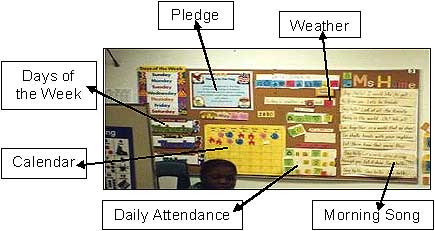
Reducing the amount of information will likely increase on-task behavior and understanding during morning meeting. Consider displaying the information only as needed during the activity. Placing materials on foam board or a flip chart may be helpful, as they can easily be put away when not in use (see Photo 2).
Photo 2
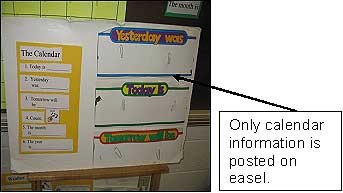
Other questions to ask include:
- Is the circle area clearly defined to students?
- Is it clear to students where to sit?
- Do students need supportive chairs with arms or backs?
Students with ASD may process sensory and perceptual information differently than their peers, and may have greater difficulty in organizing their bodies. Sitting on the floor may be challenging for some students with ASD, and staff may consider providing additional physical structure for specific students (see Photo 3).
Photo 3
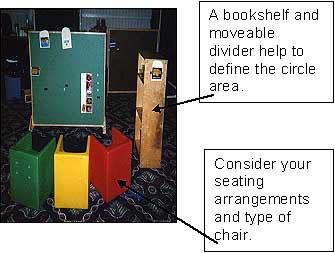
Providing visual supports
The use of visuals is recommended to encourage understanding of abstract concepts and to support students with ASD when learning new skills during morning meetings. Students with ASD are less likely to process auditory information as quickly as their peers, and they may need ideas and constructs presented in a more concrete way. Visuals can be used for a variety of purposes during circle-time activities.
To present a schedule of activities: it is important for students to have an understanding of what activities will take place during group time and how long activities will occur. Creating a visual schedule that represents the sequence of activities that will take place during circle time is an effective strategy, as it allows the student to “see” rather than “hear” the order of events. Presenting the information to the students prior to the start of the activity, and then allowing the student to manipulate the schedule as activities are completed, are helpful ways to increase engagement and understanding (see Photos 4 and 5).
Photo 4 |
Photo 5 |
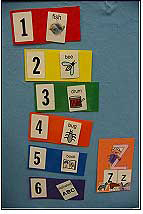 |
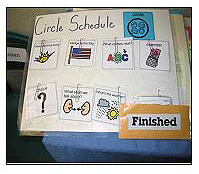 |
Visual representations of the activities that will take place during circle-time. When each activity is finished, the numbered strip/picture card is removed from the board and placed in a container/envelope labeled “Finished.”
To help make abstract concepts and routines more concrete: because of the abstract nature of the language-based activities addressed during morning meeting, consider adding pictures or objects for students to use, hold, or refer to during group activities. This may include making charts with written or picture directions, giving students objects to manipulate during songs, and/or creating visual representations of song verses, classroom poems, or stories read. Allowing student with ASD to interact with materials during circle-time will likely increase engagement and meaning (see Photos 6-9).
Photo 6
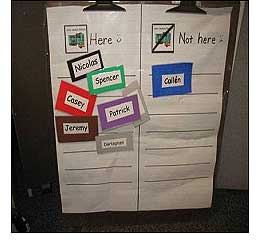
A chart with pieces that students manipulate to indicate the students who are in attendance and those who are absent.
Photo 7
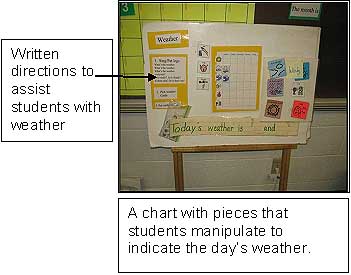
Photo 8
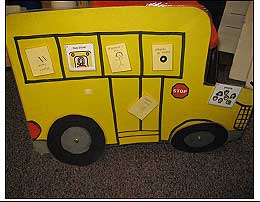
A visual to display the verses for the “Wheels on the Bus” song. Students select a verse, then put it in a “Finished” envelope when the verse is completed.
Photo 9
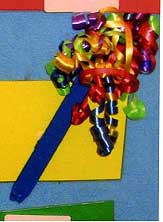
A shaker students can hold and manipulate during a song.
To clarify rules and group expectations: students with autism may have difficulty understanding what is expected of them, and may not attend to social or non-verbal cues related to their behavior. This non-understanding may lead to increased anxiety or frustration during morning meeting activities. Using visuals to illustrate what is expected will assist in providing predictability to students with ASD (see Photos 10-12).
Photo 10
 |
 |
 |
| Quiet Voice | Hands in Lap | Sit in Chair |
Photo 11
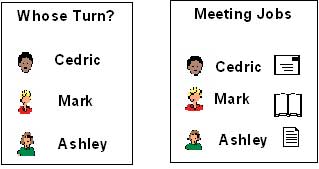
Visuals to indicate the order in which students will participate and/or what job a student must complete.
Photo 12
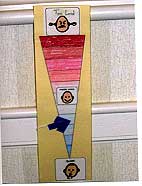
A visual to help students with voice volume during circle-time activities.
More tips to help make the most of morning meeting
- Consider teaching some of the circle-time activities to students in a calmer, less social environment. If a student is struggling to understand or participate in the activities during circle-time, it is less likely he/she will have available energy or attention to dedicate to social engagement or group interaction. If students have acquired the concepts prior to coming to circle, they may be more inclined to generalize the skills during the group activity, and enjoy the experience.
- When using visual supports during the morning meeting, it is important to both individualize and take time to teach the student how to use/interpret the support. If line drawings (as illustrated by the Board Maker icons) are not meaningful to students, consider using photographs or objects to represent the same ideas. Simply having or presenting the visuals may not be as beneficial as actively teaching the students how to respond to or interact with the supports when presented.
- Think about how staff members are participating during circle-time activities. If staff is consistently redirecting students or physically managing students during group time, it may be necessary to rethink the concepts covered or the structure of the group. Consider implementing a layered group, and instead use staff members to facilitate activities that will occur when students are transitioned after the first layer of circle.
- Incorporating a student’s special interest into morning meeting activities may also be a valuable strategy in increasing engagement and participation. This may include adding “Digimon” characters to the calendar numbers, singing a Thomas the Train song, or asking questions about a favorite sports team.
- Most importantly, circle time is intended to be fun, and to demonstrate to students with ASD the value of sharing experiences with peers in a group setting. If the activities and experiences are no longer enjoyable for staff or students, or if redirecting challenging behavior has become the focus, consider incorporating several of the strategies discussed to increase the meaning for students with ASD, and to increase the fun.
Hume, K. (2006). Making the most of morning meeting. The Reporter, 11(3), 10-14.
